C.P. - Chemically pure. This designation is sometimes applied to commercial pigments which are entirely free of extenders or any added inert pigments.
crackle - In ceramic glazes, a network of fine craze lines, produced intentionally or accidentally, especially associated with oriental and modern porcelain. Also, in oil painting, when the paint's surface is broken by a network of small cracks.
Example:


China,
Canton, Footed
Bowl, late 18th, early 19th century, crackle-craze underglaze, off-white and blue,
2 1/2 x 5 3/4 inches, height
of foot 1/2 inch. Enlargement of the inverted view. This was
made expressly for export.
craftsmanship - The quality of what a person does. Craftsmanship is most admired when a person creates with skill or dexterity, usually with the hands, whether with or without tools.
An example:
Robert Nanteuil (French , 1623-1678), Portrait of Louis XIV, 17th century,
engraving,
49.7 x 42.6 cm (image) inches, Fine Arts Museums of San Francisco,
CA. Nanteuil was the official engraver of portraits for King
Louis XIV.  The
excellence of his engravings' craftsmanship
has never been surpassed.
The
excellence of his engravings' craftsmanship
has never been surpassed.
Quote:
Also see hallmark and obsession.
cramp - See clamp.
crater - See krater.

crayon - Traditionally, any drawing
material made in stick
form, including chalk,
pastel, conté
crayons, charcoal, lithographic and other grease crayons,
as well as wax crayons.![]() To children, the
term invariably refers to these last sticks of color
made of paraffin, and marketed under various trade names, available
in several sizes and shapes, either water-soluble
or not, usually in a paper wrapper.
To children, the
term invariably refers to these last sticks of color
made of paraffin, and marketed under various trade names, available
in several sizes and shapes, either water-soluble
or not, usually in a paper wrapper.
(pr. KRAY-ahn or KRA-ən)
A related link:

crazing - A network of cracks which sometimes forms in ceramic glazes; crackle. It may be desirable or not, depending on the artist's wishes. It is caused by the glaze and clay body contracting at different rates as they cool after firing.
Example:


China,
Canton, Footed
Bowl, late 18th, early 19th century, crackle-craze
underglaze, off-white and blue, 2 1/2 x 5 3/4 inches, height
of foot 1/2 inch. Enlargement of the inverted view. This bowl
was made expressly for export. See invert.
A similar pattern in the surface of oil paints is known as crackle instead of crazing. Crackle in oil paintings is less likely when the painter follows the rule of fat over lean — when oil colors will be applied in layers (coats), the first layer should be leanest (least oil) followed by layers with progressively more fat (more oil.) Following this principle results in a work less likely to crack in aging. Similarly, in order to encourage crazing, later coats should have less oil than earlier ones.
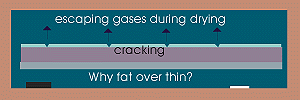
creative process - See creativity.
creative self-expression - The art education paradigm emphasizing the making of art for self-expression — a personal exploration of a variety of art materials and methods. Creative self-expression dominated the field of art education from the 1940s to the late 1980s, until the formulation of discipline-based art education (DBAE).
Also see art therapy.
![]() crenel, crenelation, crenelated
- In architecture, crenelation
is the indented or notched construction of the battlements atop
a wall;
crenel, crenelation, crenelated
- In architecture, crenelation
is the indented or notched construction of the battlements atop
a wall; a crenelated wall is one topped with
merlons — pieces of wall protecting defenders who looked through
and used their weapons through the notches, or crenels. Crenelation
is most typically located on a fortification's parapet.
a crenelated wall is one topped with
merlons — pieces of wall protecting defenders who looked through
and used their weapons through the notches, or crenels. Crenelation
is most typically located on a fortification's parapet. Here are three of the possible shapes
of crenelation.
Also see arms and armor, corbel, embrasure, masonry, and splayed opening.
crepidoma - The stepped base of a Greek temple.
crepuscular - Of, relating to, or like twilight. Or, dim; indistinct; glimmering; imperfectly luminous; obscure. The early Romans had two words for "twilight." English writers began using "crepuscular" in the 17th century, having borrowed it from the "crepusculum" used by Romans for the half-light of evening, just after the sun sets; it is a diminutive formation based on their word for "dark," which is "creper."
(pr. krə-PUSS-kyə-lər)
Examples of crepuscular light:
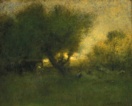
George Inness (American, 1825-1894), In the Gloaming,
1893, oil on canvas, Hood Museum of Art, Dartmouth College, NH. The gloaming is synonymous with twilight.

John Singer Sargent (American, 1856-1925),
Carnation, Lily, Lily, Rose, 1885-6,
oil on canvas,
174.0 x 153.7 cm, Tate Gallery, London. Although not usually
considered an Impressionist,
Sargent was enthusiastic about painting en
plein air. He painted this picture out of doors during
a very brief period each evening when the light was at the same
level, just after sunset — a procedure explored by Impressionist
painters such as Claude Monet (French, 1840-1926), whom he knew
personally.

Georges Seurat (born Georges-Pierre Seurat)
(French, 1859-1891), Evening, Honfleur, 1886, oil
on canvas, 25 3/4 x 32 inches
(65.4 x 81.1 cm), Museum of Modern Art, NY. See Neo-Impressionism and reflection.
Also see candela, color, light, luminism, luminosity, nocturne, nyctalopia, pearlescent, penumbra, shade, shading, shadow, and tenebroso or tenebrism.
critic - See art critic, art criticism.
criticism - See art critic, art criticism, critique, and discussion.
critique - A critical review or discussion, in particular, for our purposes, one dealing with works of art. A critique is often a meeting involving a group of art students with one or more instructors, and sometimes one or more guests, in a discussion resulting in the assessment of those students' artwork, to review or discuss those works critically in order to sustain and nourish critical reflection. Participants in a critique should focus on describing, analyzing, interpreting, and judging works to an understanding of them which is as deep and broad as time will allow. The works considered in a critique might constitute a portion of a project to be completed within the current semester, up to a large body of recent works. A critique should advance the students' work, and convey a structure which will sustain them as artists long after their graduation.
Unfortunately, to many people, the word "criticize" has a negative, and therefore off-putting connotation. Art educators, however, employ "criticism" and "critique" as means to convey the feedback art students need: a concentrated effort to give constructive analysis and advice. All participants should affirm that a critique is most helpful when it is simultaneously profoundly insightful and motivating — entirely truthful, and free from ridicule.
(pr. krə-TEEK)
Quotes:
Also see art critic, art criticism, bias, charette, interesting, and praise.
crocket - In architecture, an ornament, usually in the form of curving leaf, found on the sloping edge of a gable, pinnacle, flying buttress, etc., of a Gothic building.
Cro-Magnon - Of or pertaining to the homo sapiens whose remains, dating from the Aurignacian period, were found in the Cro-Magnon caves in Dordogne, France. The French Ministry of Culture maintains several Web pages about sites in France.
Also see Stone Age.
cromlech - A prehistoric monument, consisting of a mound surrounded by a circle of monoliths.
Also see archaeology, cairn, dolmen, megalith, obelisk, and Stone Age.
crop and crop mark - To crop is to trim one or more of a picture's edges, or to place one or more of the edges of an image so that only part of a subject can be seen within the image.
Examples:

Mathew Brady (American, 1823-1896) Studio,
Robert E. Lee (1807-1870), 1865, albumen
silver print, 8 3/16 x 6 inches (20.8 x 15.3 cm), National Portrait
Gallery, Smithsonian Institution, Washington, DC. Although this portrait was originally
in a rectangular shape,
the photographer chose to crop it to an oval
shape.

Édouard Manet (French, 1832-1883), Boating, 1874, oil
on canvas, 38 1/4 x 51 1/4
inches (97.2 x 130.2 cm), Metropolitan Museum of Art, NY. (On
the Met's page, you can enlarge any detail.) This picture was
composed so that much of the sailboat was cropped.
See en plein air.
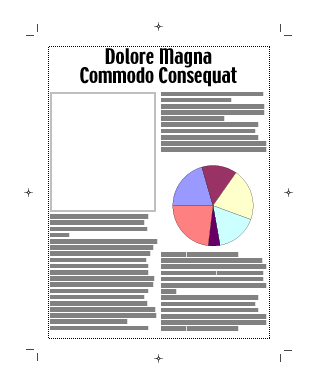
A "crop mark" is any mark
that clearly shows where material
should be cut off, typically after an image
has been produced, usually once it has been printed. In this example a crop mark has been placed outside of
each corner of the dotted-line surrounding the printed area, so
that a white margin will
remain once the image has been cropped. Crop marks should not
be confused with register marks — here placed outside of the centers of sides of the printed area. Register
marks help in aligning the
printing of separate colors.
Also see bleed mark, frame, mat, and placement.
cross-barrel vault - In architecture, a barrel (or tunnel) vault in which the main barrel (tunnel) vault is intersected at right angles with other barrel (tunnel) vaults at regular intervals.
Also see cross vault.
crosscut saw - A saw with fine teeth set and angled to cut transversely through the grain of a dense material, usually wood.
Also see circular saw, kerf, and ripsaw.
cross-hatching - See hatching.
crossing - The space in a cruciform church formed by the intersection of the nave and the transept.
Example:
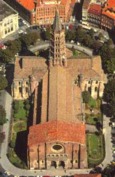

France, Toulouse, St. Sernin, c. 1080-1120,
Romanesque cathedral.
An
aerial
view photograph of St. Sernin from one angle (the tower is
of 1250 with its spire of 1478 belongs to the Gothic period) and from another angle.
![]()

![]()
A photo of the nave of St. Sernin.
See aerial view, apse, axonometric projection, capital, chapel, nave, and plan.
cross vault - In architecture, two barrel vaults intersecting each other at right angles. Also called a groin vault.
Example:
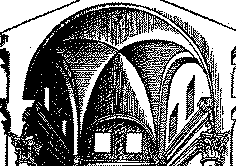
A Gothic
cross vault designed by architect Leon Baptiste Alberti (Italian,
1404-1472). Seen from this oblique
point of view, the ribs
(or ogives) resemble a drooping
X. See a larger
view.
Also see cross-barrel vault.
crucible - A heatproof vessel in which metal is made molten for pouring into a mold.
Also see melting point and temperature.
crucifix - An image or figure of Jesus Christ on the cross. The act of placing the figure there or this method of execution is called crucifixion. Christ's act of submitting to suffering and death is central to Christianity — to a belief in Jesus Christ as the savior of all of mankind from punishment for Adam and Eve's "original sin."
(pr. KROO-sə-fix)
Examples:
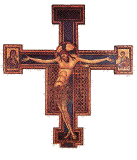
Giunta Pisano
(Italian, active in Pisa c. 1229-c. 1254), Crucifix,
1240s, tempera on wood, 316 x 285 cm,
San Domenico, Bologna. Pisan was one of many artists who were influenced by an exposure to Byzantine art resulting from the capture of Constantinople by crusaders. Pisan's crucifix is noted for the extreme expression of pathos, inspired by the Eastern iconography of the 'Christus patient', that is the Brother of Man in His suffering. Under the influence of the Franciscans this interpretation was definitely substituted for the heroic Christ, impassive, triumphing over death.
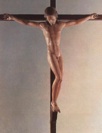
Michelangelo Buonarroti (Italian, 1475-1564),
Crucifix, 1492-94, wood,
painted, height 53 inches (135
cm), Casa Buonarroti, Florence. See Renaissance.

Workshops of the Kremlin, Moscow, Pectoral
Reliquary Cross, 17th century, gold,
silver, filigree,
enamel and niello,
15.9 x 10.6 cm, Hermitage Museum, St. Petersburg, Russia. See
reliquary.

Unknown, Crucifix, Corpus: Flemish, 1680-1720;
Cross: French, 1765-70, boxwood figure on a cross of oak veneered with ebony, inlaid
with brass, and adorned with
gilt brass mounts,
height of the corpus: 19 inches
(48 cm), J. Paul Getty Museum, Malibu, CA. "Corpus" is a Latin word meaning body. In discussing the elements of a crucifix, this term is often used in referring to the figure of Christ.

Georges Rouault (French, 1871-1958), The Crucifixion, 1920-1925, multimedia
on paper and canvas,
39 1/2 x 29 1/2 inches, Minneapolis Institute of Arts. This is
a picture of the crucifixion, rather than a crucifix. Rouault's
religious paintings are among the most highly regarded Christian
art of the twentieth century. See Expressionism.
A "perizonium" is a loin-cloth, such as that placed on the figure of Christ on a crucifix. The sign traditionally posted above the figure of Christ reads "INRI," letters standing for the Latin phrase "Jesus Nazarenus Rex Iudaeorum," meaning "Jesus of Nazareth, King of the Jews."
Also see cenacolo, Madonna, pendant, and suppedaneum.
cruciform - Cross-shaped. Examples include the letter "t" and the typical plan of Gothic churches.
(pr. KROO-sə-form)
Also see basilica, compass rose, crossing, Greek cross, labyrinth, and square schematization.
crypt - The chamber beneath the main floor of a church, usually containing graves or relics. It is typically vaulted, and wholly or partly underground. In medieval churches, it was usually under the apse or a chevet. The history of "crypt" starts with "kryptein," a Greek word meaning "to hide." From this word came "kryptos," meaning "hidden," which led to "crypta" ("vault, cavern"), another "kryptein" derivative, and the Latin predecessor of "crypt."
An example:

John Sell Cotman (English, 1782-1842), Crypt in the Church of St. Gervais, Rouen,
1819, pencil and wash
on paper, 18.4 x 27.6 cm, Tate Gallery,
London. See arch.
Also see cathedral, cryptic, and reliquary.
cryptic - Having or seeming to have a hidden or ambiguous meaning; mysterious; often marked by an often perplexing brevity. "Cryptic" sometimes carries the deeper sense of secrecy or the occult, and is often sensed in Dada and in surrealist works. The history of "cryptic" starts with "kryptein," a Greek word meaning "to hide." From this word came "kryptos," meaning "hidden," which led to "crypticus," the Latin predecessor of our "cryptic." Not surprisingly, "cryptic" is closely related to "crypt." "Kryptein" also gave us several words having to do with secret codes, such as "cryptogram" and "cryptography" (the coding and decoding of secret messages). And in fact, something "cryptic" can sometimes seem as if written in code.
(pr. KRIP-tək)
Also see absurd, amphibolous, Dada, incongruity, irony, and Surrealism.
cryptogram - A coded message or a secret symbol — a figure or representation with secret meaning or significance. Cryptograms have often been used by students of the occult.
(pr. KRIP-tə-gram)
See a discussion of the root of this word at cryptic. "Cryptography" is the coding and decoding of ciphers. The adjectival form is "cryptogrammic."
Example:
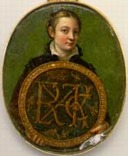
Sofonisba Anguissola (Italian, c. 1535-1625),
Self-Portrait, c. 1555, oil
on parchment, 3 1/4 x 2 1/2
inches (8.2 x 6.3 cm), Museum of Fine Arts, Boston. The artist holds a medallion
inscribed in Latin around
the rim: "The maiden Sofonisba Anguissola, depicted by her
own hand, from a mirror, at Cremona." Inside the circle
is a cryptogram whose entwined
letters are included in the
name of Anguissola's father, Amilcare. The meaning
and original purpose of this enigmatic portrait remain a mystery. See Baroque, circle,
cryptic, feminism
and feminist art, miniature,
mirror, and oval.

Britain, Enigma, 1942, a decoding machine. This
device was made by Alan Turing and other Cambridge scientists
and mathematicians, recruited by British intelligence during
World War II. Using Enigma, the Allied forces could understand
all of Germany's cryptograms.
Related link:

cube - A polyhedron having six square faces. It is also one type of hexahedron, as well as one type of prismatoid. Calculate its volume by multiplying the length of one edge by itself, then again by that product. A quantity is cubed when it is multiplied twice by the same quantity (3 cubed = 3 x 3 x 3 = 27).
Examples:
![]()

In this image,
negative spaces have been
shaped and placed
among positive spaces so
that a viewer can make closure on a cube.
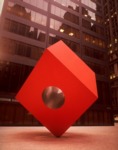
Isamu Noguchi (American, 1904-1988), Red Cube, 1968, red painted steel, Marine Midland Bank, 140 Broadway,
New York City.

![]()

Bernard (Tony) Rosenthal (American, 1914-), The Cube "Endover", c. 1968, Cor-Ten
steel, painted black, U of Michigan. Although seemingly massive, The Cube rotates
on its axis when given a
gentle push. See Minimalism.
Sol LeWitt (American, 1928-2007), Distorted Cubes (A-E), 2001, a series of five linoleum cuts; composition: 28 3/8 x 35 7/8 inches (72 x 91.1 cm); sheet: 34 13/16 x 42 3/8 inches (88.5 x 107.7 cm); composition: 28 1/4 x 35 13/16 inches (71.8 x 91 cm); sheet: 34 15/16 x 42 7/16 inches (88.7 x 107.8 cm); publisher: Pace Editions, Inc., NY; printer: Watanabe Studio, Brooklyn, NY; edition: 50; Museum of Modern Art.
Also see mathematics and art, polygon, and vertex.
cubic - Adjectival form of cube. Abbreviated cu.
cubiculum - A Roman bedroom, or a small room constructed in the wall of an Early Christian catacomb to serve as a mortuary chapel.
Example:

Rome, Cubiculum (bedroom) from the Villa of P. Fannius
Synistor, c. 40-30 BCE,
Republican, architectonic
style fresco; room:
8 feet 8 1/2 inches x 10 feet 11 1/2 inches x 19 feet 7 1/8 inches
(265.4 x 334 x 583.9 cm), Metropolitan Museum of Art, NY.
culture jamming and 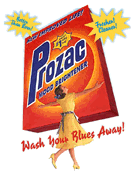 culture jammer - Culture jamming refers to forms of art and other activities involving social agitation. Culture jammers take a number of sociopolitical issues as their primary focus, including media literacy, consumerism, television addiction, television violence, pollution, North American social laziness, use of
culture jammer - Culture jamming refers to forms of art and other activities involving social agitation. Culture jammers take a number of sociopolitical issues as their primary focus, including media literacy, consumerism, television addiction, television violence, pollution, North American social laziness, use of  sweatshops, and various hazards of corporate dominance of media, government, and daily life. The term was first used in 1984 by the San Francisco audio-collage band Negativeland, but the concept dates back to the suffrage and avant-garde movements of the early 20th century. Because they often employ photomontage and other techniques employed by graphic designers, and they take stances in defiance of the status quo, their works often resemble the anti-art of the Dadaists, as well as various works by Surrealists and Situationists.
sweatshops, and various hazards of corporate dominance of media, government, and daily life. The term was first used in 1984 by the San Francisco audio-collage band Negativeland, but the concept dates back to the suffrage and avant-garde movements of the early 20th century. Because they often employ photomontage and other techniques employed by graphic designers, and they take stances in defiance of the status quo, their works often resemble the anti-art of the Dadaists, as well as various works by Surrealists and Situationists.
Quote:
Related links:
Adbusters is a magazine and a web site published by Kalle Lasn.
The Billboard Liberation Front has been "establishing a new paradigm in street marketing" since the 1970s.
Free Press is an American nonpartisan organization working to increase informed public participation in crucial media policy debates, and to generate policies that will produce a more competitive and public interest-oriented media system with a strong nonprofit and noncommercial sector.
Urban75 advocates "billboard improvement."
Also see advertising, detournement, First Amendment Rights, and visual culture.

cuneiform - The wedge-shaped depressions made by the ancient Mesopotamians in clay in order to inscribe the characters of their written language. It was in southern Mesopotamia, or more precisely in Uruk, around 3100 BCE, that writing appeared for the first time in the world, initially pictographic writing, "drawing" the elements of the real world. In this region the earliest known records have been found of political, military and religious administration, set up to administer new complex town structures. As these regions developed, so cuneiform writing also began to appear.
In 1838 Henry Rawlinson (English, 1810-1895) became the first modern scholar to decipher cuneiform writing. He was studying inscriptions on tablets Persian king Darius I had made in the sixth century BCE to record his victory over a group of rebels. Rawlinson noticed that same information is written in each of three languages: Old Persian, Babylonian and Elamite. Rawlinson worked out which cuneiform marks spelled the name Darius in Persian and compared them with the marks used to write the name in Babylonian. He then deciphered many of the other signs and words. Egyptian hieroglyphs were deciphered by similar means.
(pr. kyoo-NEE-ə-form)
Examples:
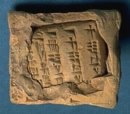
Mesopotamia (possibly Nippur. Ur III, c.
2044 BCE),
Tablet in an Envelope, clay, Michael C. Carlos Museum, Emory U, Atlanta, GA. A writer
who wished to prevent tampering with a letter or another important
text sometimes wrapped it, as this one was, in a clay envelope
on which the writer re-recorded the text and applied a seal.
Any effort to tamper with such a message would then be discovered.
Mesopotamia (Babylon, Neo-Babylonian Period, Reign of Nabopolassar, 625-605 BCE), Cuneiform Cylinder of Nabopolassar Recording Repair of the City Wall of Babylon, clay, 3 7/8 x 2 1/16 inches (9.8 x 5.2 cm), Michael C. Carlos Museum, Emory U, Atlanta, GA.
Also see font, glyph, icon, ideogram, lettering, logo, petroglyph, pictograph, text, and typography.
cupola - A dome, especially a small one which is surmounted by a lantern.
cupreous - Of or containing copper; copper-like. Or, having a color which is metallic reddish-brown; copper-colored.
(pr. KYOO-pree-əs, or KOO-pree-əs)
curator - A person who is responsible for collection building, care, research, exhibition, and writing. Curators often work with community members to determine interests and needs, which will be reflected in special exibitions, and result in the meeting educational goals.
Also see art careers, art conservator, director, docent, museum, preparator, registrar, and typology.
cure - The hardening process of a material which is worked in a moist or liquid form, such as resin and concrete. To mature.
currency - See numismatics and currency.
cursive - Of flowing writing with strokes joined and angles rounded.
Also see calligraphy, font, fontography, scriptorium, scroll, text, typeface and type, and typography.
curtain wall - In castles, the surrounding fortified walls. In modern architecture, an outer non-load-bearing wall, often simply a field of large panes of glass held in place with a lattice of other material, sometimes merely thin metal bands. The modern curtain wall was first made possible with the introduction of the structural steel skeleton by watchmaker and inventor James Bogardus, using modular prefabricated cast iron and glass in New York City in 1849. Other notable progress in this direction was made by architects Louis Sullivan (American, 1856-1924), in the Carson-Pirie-Scott store (Chicago, 1899-1904), and Walter Gropius (German, 1883-1969), whose design for the Bauhaus (Germany, 1926) became the precursor to the "glass box" building of the International style.
Examples:
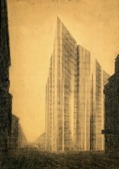
Ludwig Mies van der Rohe (German, 1886-1969),
Friedrichstrasse Skyscraper, Berlin-Mitte, Germany,
a project in 1921, this is a perspective
drawing from
the north, charcoal and pencil on tracing
paper mounted
on board, 68 1/4 x 48 inches (173.4 x 121.9 cm), Museum of Modern
Art, NY. This design
for a twenty-storey tower
was based on the then-untried curtain wall idea: that a supporting
steel skeleton would
be able to free the exterior walls from their load-bearing function, allowing a building
to have a surface that is
more translucent than solid.
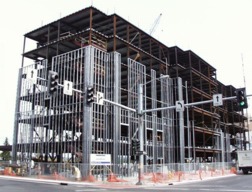
A typical contemporary curtain wall building
under construction. Steel
posts and beams
hold the building up as it receives its non-load-bearing "skin"
of aluminum framework for walls
and windows.
Also see bearing wall and fenestration.
 curve - A line
or edge that deviates from
straightness in a smooth, continuous
way. Or, a surface that deviates
from flatness in the same
way. Or, something that has the shape
of a curve, such as an arc.
Or, to make something curve, such as when a straight piece of
wire is made to be curved. A
curlicue is a curve with flourish.
curve - A line
or edge that deviates from
straightness in a smooth, continuous
way. Or, a surface that deviates
from flatness in the same
way. Or, something that has the shape
of a curve, such as an arc.
Or, to make something curve, such as when a straight piece of
wire is made to be curved. A
curlicue is a curve with flourish.
(pr. kərv)
Also see aliased and anti-aliased, circle, cone, curvilinear, cylinder, ellipse, French curve, helix, mandala, meander, oblong, organic, oval, ovoid, parabola, radial, sphere, tangent, tondo, and volute.
curvilinear - Formed or characterized by curving lines. Elements of late Gothic and Art Nouveau ornament are examples of curvilinear treatment of form. Also curvilineal.
Examples:

Designed by Hector Guimard (French, 1867-1942),
Panel, c. 1900, early 20th century, silk
and paint on silk, width 18
inches (45.7 cm), length 27
inches (68.6 cm), Metropolitan Museum of Art, NY. See Art Nouveau.
.

Elie Nadelman (American, born Poland, 1882-1946),
Dancer, c. 1918-1919, cherrywood, The Jewish
Museum, NY. See Jewish art, sculpture, and wood.

Tamara de Lempicka (American, born Poland,
1898-1980), Calla Lilies, 1941, oil,
private collection, CA. See Art
Deco and Polish art.
Also see arabesque, crown, flourish, helical, meander, sikhara, and volute.
cusp - The projecting point on the inner side of an arch, window, or rondel.
Also see fenestration and pendant.
custom - A practice followed by people of a particular group or region.
Also see culture, ethnosphere, heritage, and tradition.
cute - Pretty, dainty, precious.
(pr. kyoot)
Also see aesthetics, beauty, collectible, feminism and feminist art, nice, positive, and praise.
cutout or cut-out - In art, a piece of paper cut into a shape and arranged with other cutouts to form designs and picture.
Examples:
Henri Matisse (French, 1869-1954), Icarus, Jazz, 1943, stencil print, 16 5/8 x 10 5/8 inches, published by Tériade as plate 8 in Jazz. Matisse is the most reknowned maker of cutouts.
Henri Matisse, Polynesia, the Sea, 1946, gouache on paper, glued onto paper, Musée National d'Art Moderne, Centre Georges Pompidou, Paris.
Henri Matisse, The Bees, summer 1948, gouache on paper, glued onto paper, 39 3/4 x 94 7/8 inches, Matisse Museum, Nice.
Henri Matisse, The Snail, 1952-53, gouache on paper, glued onto paper, 112 5/8 x 113 inches, Tate Modern, London.
Henri Matisse, Black Leaf on Green Background, 1952, Menil Collection.
Saul Steinberg (American, born Romania, 1914-1999), Cutout Family, cutout white paper mounted on black paper.
Other resources:![]()

Celebritycutouts.com sells life-size cardboard
cutouts of photos of pop culture celebrities — entertainers,
ploiticians, etc. "Great for parties and special events
whether it's for school, business or personal enjoyment." See lifesize.
Also see adhesives, French curve, pochoir, silhouette, stained glass, and template.

![]()
 cyan
- The blue-green subtractive
primary color which absorbs
red and transmits blue-green; that is, white light
minus red.
cyan
- The blue-green subtractive
primary color which absorbs
red and transmits blue-green; that is, white light
minus red.
(pr. si:-ANN)
Also see additive colors, CMYK (cyan magenta yellow black), and penumbra.
cyanotype - A very direct photographic process resulting in monochromatic images in tints and tones of blue. It first appeared in 1842.
Examples:
![]()
Anna Atkins (English, 1799-1871) and Anne
Dixon (English, 19th century), Equisetum sylvaticum, 1853, cyanotype
photogram,10 x 7 7/8 inches,
J. Paul Getty Museum, Malibu, CA. Anna Atkins produced the first
photographically illustrated book, British Algae: Cyanotype
Impressions, in 1843. She included this photo in her second
book, Cyanotypes of British and Foreign Ferns, c. 1860.

Hippolyte Bayard (French, 1801-1887), Arrangement of Specimens, Paris, about
1842, direct positive print (cyanotype photogram),
10 15/16 x 8 1/2 inches (27.7 x 21.6 cm), J. Paul Getty Museum,
Malibu, CA.

American photographer, Ten Children, c. 1898, cyanotype, 5 x
8 inches, American Museum of Photography. This group portrait
was apparently made in the rural South.
Cycladic art - The art of an ancient (c. 2800-1400 BCE) culture on a group of islands of southeast Greece in the southern Aegean Sea, especially those surrounding the small island of Delos.
(pr. si-KLA-dək)
Examples:

Cyclades, c. 2800-2700 BCE,
Statuette of a seated harp player, late
Early Cycladic I-Early Cycladic II, marble,
height with harp 11 1/2 inches
(29.21 cm), Metropolitan Museum of Art, NY. See statuette.

Cyclades, attributed to the Bastis Master,
c. 2600-2400 BCE,
Statuette of a woman, Early Cycladic
II, late Spedos type, marble, height 24 3/4 inches (62.79 cm),
Metropolitan Museum of Art, NY.
![]()
Greece, Cyclades, about 2500 BCE,
Male Harp Player, marble,
14.1 x 3.7 x 11 inches (35.8 x 9.5 x 28 cm), J. Paul Getty Museum,
Malibu, CA.
Also see archaeology, Greek art, Minoan art,
Mycenaean art, and mythology, statue, and statuette.
Cyclopean - Gigantic, vast and rough; massive. Cyclopean architecture is a method of stone construction using large, irregular blocks without mortar.
(pr. si:-KLOP-ee-ən)
Also see colossus and colossal, dolmen, mass, rustication, and size.
cylinder - A three-dimensional
surface generated by a
straight line
(a generatrix) intersecting
and moving along a closed plane
curve (the directrix)
while remaining parallel to
a fixed straight line that is not on or parallel to the plane
of the directrix. The portion of such a  surface
bounded by two parallel planes and the regions of the planes bounded
by the surface. A solid bounded
by two parallel planes and such a surface, especially such a surface
having a circle as its directrix.
Or a cylindrical vessel or object.
Generally refers to a right cylinder — having end planes both
parallel and at 90 to the generatrix. Calculate volume
of a right cylinder as pi
(3.14159) times the radius squared times the length of the generatrix.
The surface area of a right cylinder (including the circular ends)
is 2 times pi times the radius times the product of the radius
plus the length of the generatrix. The surface area of the lateral
area (not including the circular ends) of a right cylinder is
2 times pi times the radius times the length of the generatrix.
Canisters, drums, and rolling pins are typically cylindrical in
form. Any of several parts of a printing
press that rotate, especially the one that carries the paper.
In archaeology, a cylindrical
stone or clay
object with an engraved
design or inscription. (pr. SI-lən-dər)
surface
bounded by two parallel planes and the regions of the planes bounded
by the surface. A solid bounded
by two parallel planes and such a surface, especially such a surface
having a circle as its directrix.
Or a cylindrical vessel or object.
Generally refers to a right cylinder — having end planes both
parallel and at 90 to the generatrix. Calculate volume
of a right cylinder as pi
(3.14159) times the radius squared times the length of the generatrix.
The surface area of a right cylinder (including the circular ends)
is 2 times pi times the radius times the product of the radius
plus the length of the generatrix. The surface area of the lateral
area (not including the circular ends) of a right cylinder is
2 times pi times the radius times the length of the generatrix.
Canisters, drums, and rolling pins are typically cylindrical in
form. Any of several parts of a printing
press that rotate, especially the one that carries the paper.
In archaeology, a cylindrical
stone or clay
object with an engraved
design or inscription. (pr. SI-lən-dər)
Examples:

Mesopotamia, Cylinder seal and modern impression: hunting
scene, 2250-2150 BCE,
Late Akkadian period, chert, height
1.1 inches (2.8 cm), Metropolitan Museum of Art, NY.

Guatemala, Petén Department, Maya
peoples, Vessel with Mythological Scene, 8th century
CE,
ceramic, height 5 1/2 inches (14 cm), Metropolitan
Museum of Art, NY. See mythology
and Pre-Columbian art.
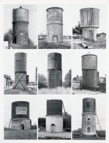
Bernhard Becher and Hilla Becher (German,
1931-2007, and 1934-), Water Towers
(Cylindrical), 1978, composite of nine gelatin silver
prints, Milwaukee Art Museum, WI. See photography and technology.
Also see anamorphosis, arc, kaleidoscope, snake, sphere, and volute.
Czech art - Much more coming soon!
Examples:
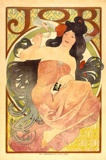
Alphonse Marie Mucha (Czech, 1860-1939), Job, 1898, lithograph in five colors: red, yellow, blue green, dark violet, and black, 54 1/2 x 36 1/2 in. (138.43 x 92.71 cm). This poster advertised a brand of cigarette papers. See Art Nouveau.

Alphonse Marie Mucha, Maude Adams (1872-1953) as Joan of Arc, 1909, oil on canvas, 82 1/4 x 30 inches (208.9 x 76.2 cm), Metropolitan Museum of Art, NY.

Frantisek [aka Franz or Frank] Kupka (Czech, 1871-1957), Plans verticaux I, 1912-1913, oil on canvas, 150 x 94 cm, Georges Pompidou Center, Paris. See abstraction.

Frantisek Kupka, Hindu Motif, c. 1919-1923, oil on canvas, 124.5 x 122 cm, Georges Pompidou Center, Paris. See Orphism.

Frantisek Kupka, Study from Mechanistic Series, 1923-1926, gouache and pencil on paper, 28 x 28.2 cm, Tehran Museum of Contemporary Art, Iran.
Quote:
Related links:
Also see Austrian art, flag, German art, Hungarian art, Polish art, and Russian art.
https://inform.quest/_art